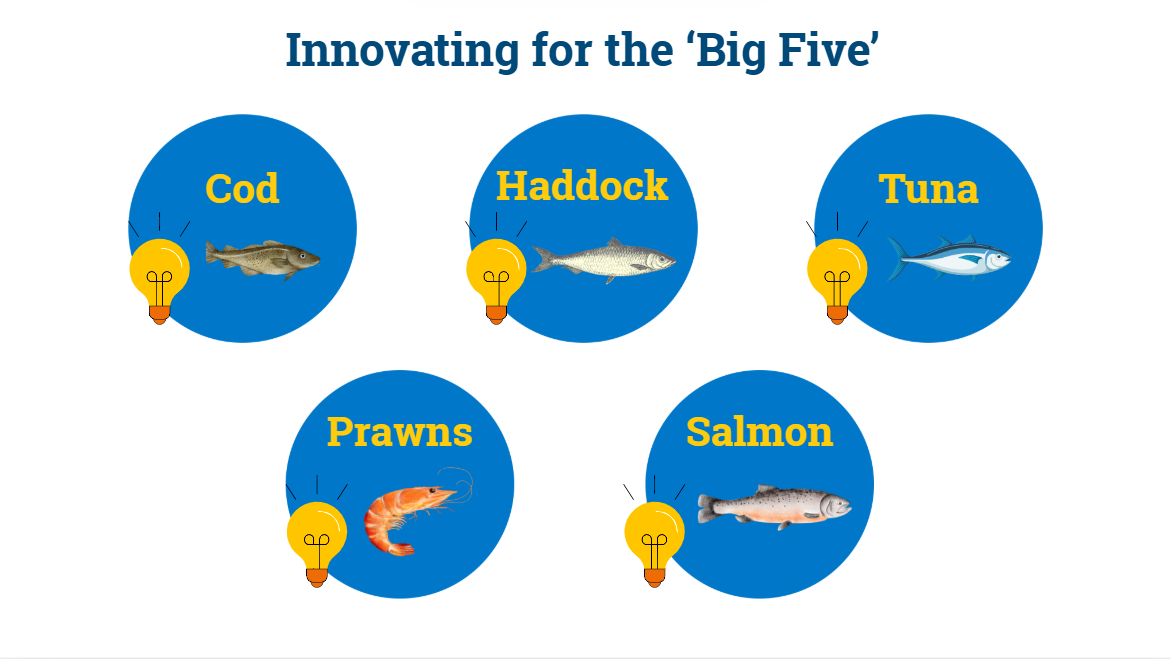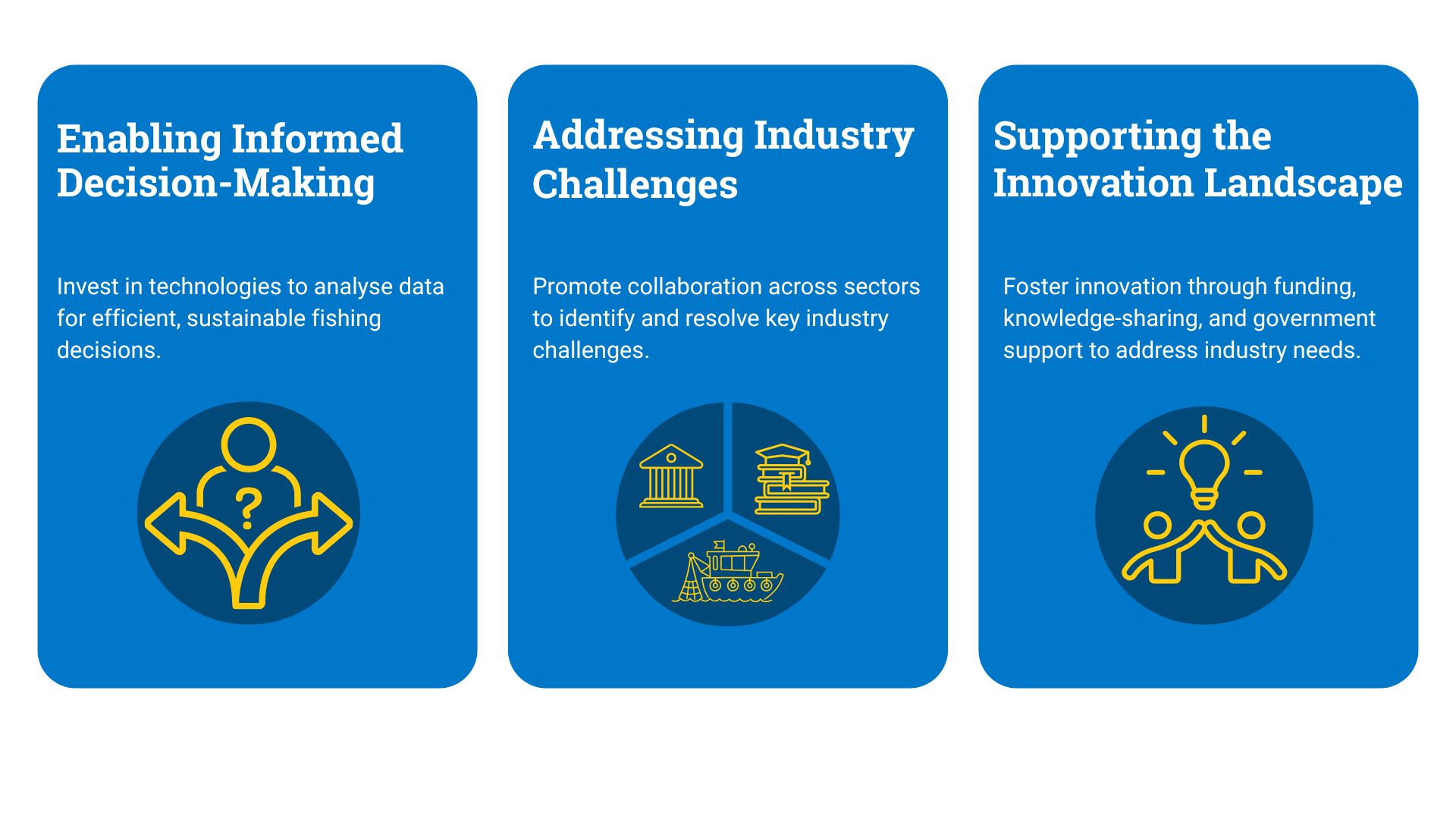Innovation: at the heart of a thriving seafood industry
The salty tang of the sea air. The rhythmic clatter of nets. The hypnotic view of fish shoaling. Vivid images of the UK’s coastal fishing heritage. But today’s seafood sector is much more modern than that. It uses some of the highest tech AI, robotics, sensors, and satellite monitoring data available and is quick to adopt the latest technologies. It harnesses the desire of consumers for safe, tasty seafood that’s sustainably sourced throughout the entire supply chain.

A legacy of innovation
The UK has a world-renowned track record of innovation, from centuries-old achievements – such as the steam engine or the spinning jenny – to discoveries from more recent decades - like the internet, big data and advances in genomics - that underpin our capacity to communicate and to find new solutions to health and longevity. That legacy continues, with science and tech-led sectors driving economic growth. These can all bring benefits to the UK’s seafood sector.
Innovating for the ‘big five’
Fishing and aquaculture, or fish farming, are the cornerstones of the UK seafood industry and together are essential for a robust and future-proofed supply chain with an essential role in feeding a growing global population.
The catching sector supplies two of the ‘big five’ fish species, well known to us as iconic British whitefish. Cod and haddock are familiar to anyone who has visited their local ‘chippy’.
With climate change leading to shifting fish stocks, the UK fishing fleet is modernising by adopting innovations that improve efficiency and help vessels minimise fuel costs whilst targeting fishing activity to catch the fish the market wants.
That includes selective fishing gear, like pulse trawls and using light to attract the particular species of fish you want to catch. Techniques like this can reduce unintended bycatches and minimise impacts on the seabed. Electronic monitoring systems can provide real-time data on catch composition and location, allowing more effective management of fisheries.
The importance of aquaculture continues to grow worldwide and supplies UK consumers with high-value species such as tuna, prawns and salmon (the other 3 ‘big five’ seafood species that are purchased more often than any others in the UK) in a sustainable and non-depleting way. Much innovation in aquaculture is happening fastest in the farmed salmon sector, with good examples of new developments being trialled in the UK.
The UK’s Seafood Innovation Fund, with the involvement of bodies including Seafish, has supported a range of initiatives to help the fishing fleet, processors and our shellfish farmers drive up the efficiency of their activities, leading to even higher quality products in UK restaurants and on supermarket shelves.

Changing times
We know that ‘the times they are a-changing’. Every fisherman or fish farmer sees just how changeable, unpredictable and unsettling the weather can be - and climate change means that unpredictability continues.
At a different level, change is also happening in terms of what consumers want, the volatility of international markets, how we value and measure sustainability, and how we source, grow, process and deliver food to customers. Yesterday’s technologies and ways of doing things are no longer enough. The UK needs to stay at the vanguard of progress, to help us navigate these unsettling changes.

Improving methods, products and ideas
Our definition of innovation, therefore, encompasses continuous improvement of methods, products, and ideas. Some of those may be radical, game-changing technologies that disrupt how things are done now.
But many innovations will be less obvious, but just as impactful. They can enhance current fishing and farming practices, thus adding value throughout the supply chain as we optimise our use of limited resources. Process innovations reduce waste in the supply chain and satellite and data technologies increase the effectiveness of where and how we fish and farm. Transferring knowledge and know-how by applying insights and understanding from one industry or sector to another is a great way to improve the UK seafood supply base.
Three ambitions for seafood innovation
So, how can innovation be supported to emerge, transform and be adopted throughout the UK seafood supply chain? There are three things I’d love to see happen.
1.Enabling informed decision making
We need to showcase new ways of doing things that can make the work of fishers and fish farmers more efficient and sustainable by applying insights from data. We need the right technology to collect data, analyse it and use it to make informed decisions, whether that’s records of which fishing gear yields optimal catches, or to understanding the best time to stock or harvest shellfish farms, so we can deliver seafood products that consumers value. We need to understand the complex dynamics of our marine ecosystems, track fish stocks, predict algal blooms and monitor water quality in real time.
That means investing in sensors, remote monitoring systems and data analytics platforms. Some of that is already happening in some parts of the seafood sector. There are many opportunities for more holistic, joined-up approaches to leverage the insights from such data.
2. Addressing industry challenges
We must help the industry clearly describe the challenges they face that are ripe for innovation. We need to foster collaboration between industry, academia, and government, ensuring that all work together to address the challenges. We can create economies of scale in terms of amping up the nature and volume of conversations between those who fish for and farm seafood in UK waters, those who process and sell seafood products, and those with innovative ideas who can help transform, enhance or accelerate ways to do so sustainably, reliably and efficiently.

3. Supporting the innovation landscape
We need to create a supportive environment that encourages innovation, provides access to funding, and facilitates knowledge sharing. Government investment can help bridge the large gap that exists between market-led ‘pull’ for innovation that delivers results and more curiosity-driven academic supplier-driven ‘push’ in the UK’s university base. Applied innovation is the only sort that the private sector is generally willing to invest in directly. So complementary Government spending which encourages scientists to focus on solution-oriented research is vital, resulting in innovation which delivers real-world impacts, tangible benefits and measurable dividends for society.
Applied research delivers so many benefits to consumers and societies, and indeed, we see myriad products originally generated from Government spending on science, for example, the US space programme now providing technologies that underpin areas as diverse as food safety methods, freeze-dried food, GPS locators and robotic devices. So being quicker to recognise the benefits of innovation and willing to allow piloting, experimentation and trialling of new equipment, new technologies and new ways of doing things are things the Government can and should support. With innovation, timing is often critical, so a rapidly responsive Government system can really help entrepreneurs bring new products and solutions to fruition.
Planet and people
Whilst innovation is a key driver of economic growth, it can also contribute to the UK’s ambitions for good environmental stewardship and more resilient food security. With an increasingly uncertain geopolitical outlook, consumers are seeking healthy, nutritious food that represents good value for money.
As more and more young people consider vegan, vegetarian or pescatarian lifestyles, we know that the ethics of food production matters to society too: animal welfare is an increasingly important consideration to supermarket buyers acting as custodians of best practice for consumers. So, innovations in the way wild and farmed fish and shellfish are caught, harvested, killed and processed, and in how seafood reaches us well-preserved and in the best possible condition also contribute to the all-important factor of consumer trust. A range of exciting innovations is happening in this space across the UK’s seafood sector.
Innovation and environmental stewardship
The seafood sector’s environmental credentials matter, too. Innovation can play a crucial role in supporting marine conservation and responsible fishing practices. New technology is being applied to how we monitor fish stocks, track the movements of marine mammals, and assess the health of our marine ecosystems. Much of that is being done with support from and in collaboration with fishers and fish farmers. Sustainability gains are coming from reducing the use of diesel, switching to hybrid and renewable energy sources, reducing waste and recycling end-of-life equipment.
Innovating to navigate change
So, for me, innovation is about responding to change as much as creating change. Innovative practices can help UK seafood businesses stay profitable and competitive in their ever-evolving environment. It can help the UK seafood system as a whole to adopt more sustainable production methods, improve and enhance the sustainability of every step in the supply chain, and increase consumer confidence.
Seafood is one of the most sustainable means of providing high-quality protein to a hungry world. Greater recognition of that will increase as we tell the story of innovation’s benefits. The future of UK seafood depends on our commitment to innovation and sustainability. And the images we will associate in future with our thriving seafood sector include satellites and underwater cameras.
About Heather Jones
Heather has thirty years’ experience working directly with governments, industry and research institutions in a scientific capacity. She was formerly the Head of International Division in the Scottish Government and a Deputy Director in Marine Scotland. She has experience as a CEO; operating strategically at board level for 14 years. Heather established the UK’s first industry-led aquaculture innovation body, with 200 organisations in membership.
Her range of recent advisory roles includes the UK Seafood Innovation Fund, the Aquaculture Research Collaboration Hub, Scotland's Aquaculture Leadership Group and she is founder of the Women in Scottish Aquaculture network.